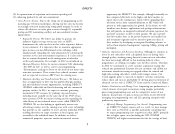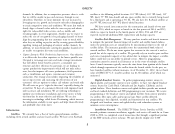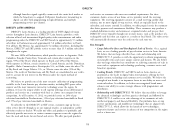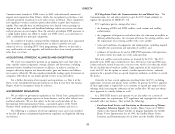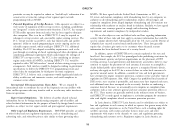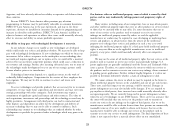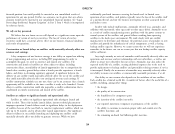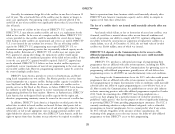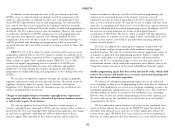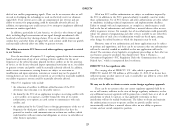DIRECTV 2012 Annual Report Download - page 37
Download and view the complete annual report
Please find page 37 of the 2012 DIRECTV annual report below. You can navigate through the pages in the report by either clicking on the pages listed below, or by using the keyword search tool below to find specific information within the annual report.DIRECTV
licenses. DBS frequencies and available DBS orbital locations capable of assigned to the DBS service. Under rules that the FCC is considering, a
supporting our business have become increasingly scarce. While we continue provider could operate a satellite in between two orbital locations where we
to explore new sources of DBS/DTH capacity, there can be no assurance have already positioned DIRECTV U.S. satellites without completing
that we will obtain further capacity. coordination of its operations and without demonstrating that such
operations would not ‘‘affect’’ the DIRECTV service. We have opposed this
In 2007, the FCC adopted new service and licensing rules for broadcasting proposal, and believe that tweener satellites as proposed by applicants would
satellite services in the 17.3-17.8 GHz and 24.75-25.25 GHz bands, or cause interference to current and planned operations and impose a
17/24 GHz BSS. This spectrum, also known as the ‘‘reverse band’’ (in that significant constraint on the further growth of our DIRECTV U.S. service.
transmissions from these satellites to consumers would occur in spectrum We cannot predict what if any action the FCC may take or the effect of
currently used for uplinking programming to traditional DBS satellites), such a proceeding on our business.
could provide a new source of additional DTH capacity. DIRECTV
currently holds authorizations for satellites in this band at two orbital The FCC has also adopted rules that require satellite operators to take
locations. However, foreign operators who may have international priority certain measures to mitigate the dangers of collision and orbital debris.
have recently brought into use conflicting ITU network filings at the two Among other things, these rules impose certain requirements for satellite
orbital locations at which we are licensed. Depending upon the ultimate design and end-of-life disposal maneuvers, which apply to eight of our
disposition of those filings, our use of one or both of these licenses may be in-orbit satellites and may in the future be applied to others. We believe
limited or precluded entirely. that we are in compliance with all of these requirements, but the
requirements could result in a slight reduction in the operational life of each
•Rules Governing Co-Existence With Other Satellite and Terrestrial new satellite.
Services and Service Providers in the MVPD Industry. The FCC has
adopted rules to allow non-geostationary orbit fixed satellite services to • Geographic Service Rules. The FCC requires DBS and 17/24 GHz BSS
operate on a co-primary basis in the same frequency band as the one used licensees to comply with certain geographic service obligations intended to
by direct broadcast satellite and Ku-Band-based fixed satellite services. In the foster the provision of DTH service to subscribers residing in Alaska and
same proceeding, the FCC concluded that multi-channel video and data Hawaii. We believe that we are in compliance with these rules. The FCC
distribution services, or MVDDS, can share spectrum with DBS operators has not acted on petitions filed several years ago by the State of Hawaii and
on a non-interference basis, and adopted rules and a method for assigning an Alaska satellite television dealer claiming a violation of those rules. We
licenses in that service. While the FCC has established service and technical cannot be sure that the FCC will not require us to make potentially
rules to protect DBS operations from harmful interference, these rules may cumbersome and costly changes to our business.
not be sufficient to prevent such interference, and such services may have a •FCC Conditions Imposed In Connection With the Liberty Media and
material adverse impact on our operations. In addition, one MVDDS News Corporation Transactions. In approving Liberty Media’s 2008
operator has received a conditional waiver of the applicable rules so that it acquisition of News Corporation’s equity investment in us, the FCC
could operate its system in Albuquerque, New Mexico at substantially imposed a number of regulatory conditions on us, some of which affected
higher power levels, which may have a material adverse impact on our our business. In granting authority for subsequent transactions in 2009 and
operations in that market. 2010, the FCC conditioned its approval on continued compliance with
In 2006, the FCC released a notice of proposed rulemaking regarding the those conditions. Accordingly, the FCC has imposed on us program carriage
possible operation of ‘‘tweener’’ or ‘‘short spaced’’ satellites that would conditions intended to prevent discrimination against all forms of
operate in the same DBS uplink and downlink frequency bands as unaffiliated programming; and conditions intended to ensure
DIRECTV U.S., from orbital positions located in between those now non-discriminatory access to programming affiliated with DIRECTV. In
17


